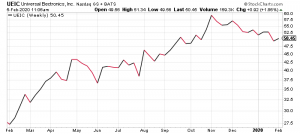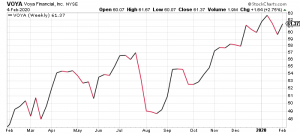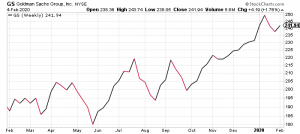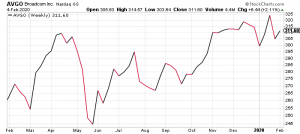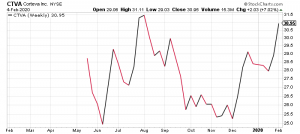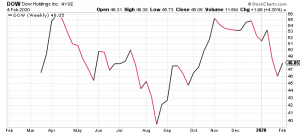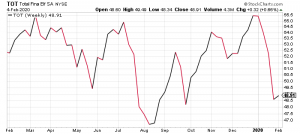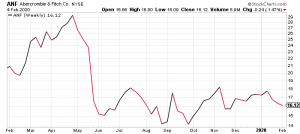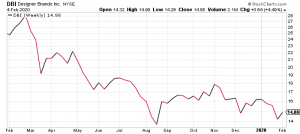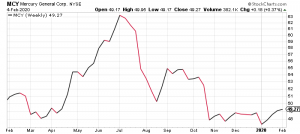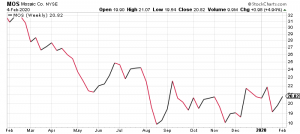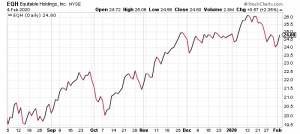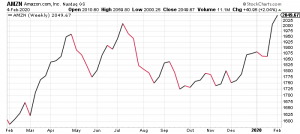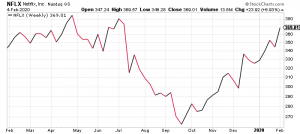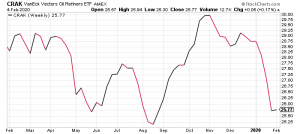Today’s featured stocks reported fourth quarter results this morning; we have a new addition to the Growth & Income Portfolio; which could deliver quick capital gains when they report earnings; and another company which gave an informative presentation at the recent Needham Growth Conference.
I also discuss the coronavirus, which could easily cause stock market turbulence through April, even if the virus dissipates quickly.
Cabot Undervalued Stocks Advisor 220
[premium_html_toc post_id="197334"]
The Stock Market Will Have A Lingering Cough After The Coronavirus Outbreak
When we all learned of the coronavirus outbreak in China, my first concern was, “Is this a normal flu or pneumonia germ, or is this a plague?”
I’m one of those “worst-case scenario” people, who likes to have all my bases covered in case something goes wrong. Once I’m all disaster-prepped, I work toward a much better outcome and I hope for the best. I’m actually quite an optimist. Let’s just say that my childhood was not calm, so “worst-case scenario” planning served me very well, and it’s simply become a lifetime habit.
At this point, I’m not worried that a plague will sweep the nations. As I watch videos made by Chinese citizens who upload the videos to the internet, I can see that death is not their major concern. Instead, they’re angry that hospitals are not offering the most basic healthcare to sick patients, and they’re chagrined that their government officials were not terribly proactive or transparent throughout this coronavirus disaster.
Now that I’m not nearly as worried that my daughter, who’s studying abroad, could become horribly ill, I can turn my attention to the potential stock market reaction to the virus.
I expect that the biggest effect of the virus on the stock market is that many companies’ first-quarter earnings will need to be revised downward, and these revisions will take share prices down a notch. These earnings revisions could be quite slow to emerge, though. So it would not be unusual for market volatility to be enhanced until the next earnings season, mid-April through May. At that point, companies will report the bald truth, everybody will know exactly where they stand, and we can proceed accordingly.
Commerce has ground to a halt in China. Therefore, all of your portfolio companies that manufacture and/or sell products and services in China will be racking up lower revenues and profits in the first quarter of 2020 than they’d originally projected. (And by the end of this quarter, we’ll certainly know if the coronavirus fades into oblivion or gathers strength, traveling the globe.) One by one, companies will announce how badly their quarterly numbers are likely to be affected, with each announcement contributing to share price volatility.
Retailers like Starbucks (SBUX) are closing their stores for a while. Automakers are ceasing production because their supply chains have been disrupted. Many workers can’t commute to work while public transportation is shut down. Airplane travel to China has largely been halted. And forget about big public venues such as entertainment theme parks and casinos. People are being urged to stay home.
I’m keeping a list of industries and companies that are most likely to experience downward earnings revisions. When the downward revisions cease, then I’ll take a lay of the land and pick the gems that still have good projected EPS growth and price charts that look ready to rebound. So far I’m monitoring airlines, cruise companies, autos, casinos, retailers and tech companies. When buy-low opportunities arise, I will be sure to alert you!
Send questions to Crista@CabotWealth.com.
PORTFOLIO NOTES
Be sure to review the Special Bulletins from January 29 and 31 in which I mentioned news, rating changes and/or price action on Alexion Pharmaceuticals (ALXN), Amazon.com (AMZN), Blackstone Group (BX), Brunswick Corp.* (BC), Corteva (CTVA), Dow Inc. (DOW) and Marathon Petroleum (MPC).
*This stock appears in Cabot’s 10 Best Buy and Hold Stocks for 2020.
QUARTERLY EARNINGS RELEASE CALENDAR
February 6 am: Total SA (TOT) – 4Q; Tyson Foods (TSN) – 1Q
February 10 am: Mercury General Group (MCY) – 4Q
February 10 pm: Voya Financial (VOYA) – 4Q
February 19 pm: Mosaic (MOS) – 4Q
February 25 am: LGI Homes (LGIH) – 4Q
Second half February: Equitable Holdings (EQH), Quanta Services (PWR) and Universal Electronics (UEIC) – 4Q
EARNINGS SEASON SCORECARD:
Big earnings beat: Amazon.com (AMZN), Blackstone Group (BX), Citigroup (C), Corteva (CTVA), Dow Inc. (DOW), General Motors (GM), Marathon Petroleum (MPC) and Schlumberger (SLB).
Earnings within 5% of consensus estimate: Alexion Pharmaceuticals* (ALXN)
Big earnings miss: Baker Hughes Company (BKR).
*at or above consensus
TODAY’S PORTFOLIO CHANGES
Goldman Sachs Group (GS) joins the Growth & Income Portfolio with a Buy recommendation.
RECENT PORTFOLIO CHANGES
Alexion Pharmaceuticals (ALXN) moved from Buy to Strong Buy.
Amazon.com (AMZN) moved from Strong Buy to Buy.
Citigroup (C) moved from Hold to Retired.
Mercury General Group (MCY) moved from Buy to Strong Buy.
Quanta Services (PWR) moved from Strong Buy to Hold.
Total SA (TOT) moved from Strong Buy to Hold.
Tyson Foods (TSN) moved from Strong Buy to Hold.
Growth Portfolio
Growth Portfolio stocks have bullish charts, strong projected earnings growth, little or no dividends, low-to-moderate P/Es (price/earnings ratios) and low-to-moderate debt levels.
Updates on Growth Portfolio Stocks
Featured stock: Universal Electronics (UEIC)
Universal Electronics (UEIC) is a manufacturer and world leader of wireless and voice remote control products, software and audio-video accessories for the smarthome, with over 400 patents and a strong pipeline of new products in the areas of safety and security, climate control and lighting. Did you know that most global HVAC systems are activated with hand-held controllers? Yes, and Universal Electronics serves that market, too. Clients include every major electronic and telecommunication company: AT&T, Cox, Dish, Comcast, Samsung, LG, Sony, Liberty, Daikin, Sky and more.
In general, investors can find very little news on the company, and only the rare change in analyst recommendations. However, CEO Paul Arling does occasionally give presentations at analyst events. In that light, investors are welcome to listen to his January 14 presentation at the Needham Growth Conference.
The average global citizen watches over four hours of TV per day; and the average American watches over six hours, including video on their phones, iPads and computers. You can see, then, that there’s great demand for Universal Electronics’ products. The company builds universal controllers that operate with all common protocols: wi-fi, RF, Zigbee, Bluetooth and more. In 2017, Universal Electronics won a Technology & Engineering Achievement Emmy® Award for their work relating to voice navigation technologies for discovering and interacting with TV content. Their technology is deployed in over half a billion devices worldwide through their QuickSet Cloud product. Nevo Butler is a newer product, a smarthome hub that can voice-enable non-voice-enabled products, such as with a viewer’s older model television.
Mr. Arling says that 2019 was the strongest year in the company’s history. (Results will likely be reported in late February.) Average selling prices are rising as the products have become more sophisticated. Investors can expect fourth quarter results to include improvement in free cash flow and gross margins, and rising profits. Going forward, the company is focused on operating margin improvement. The Board of Directors discusses potential uses of excess cash flow at each meeting. Their first goal is debt repayment. Additional considerations include share repurchases, internal investments and potential external acquisitions. Tariffs have become a waning issue, as management has already moved most production from China to Mexico.
UEIC is a volatile, undervalued, micro-cap growth stock, appropriate for risk-tolerant investors and traders. In August 2019, I named UEIC as my top stock pick for the coming year at Cabot’s 2019 Wealth Summit. I like this company because they are the clear leader in a technology field that’s experiencing constant innovation, their finances are sound, the stock is undervalued, and the company is small enough to easily be acquired by virtually any of their customers or competitors.
There are only two analysts contributing to consensus earnings estimates, so take these projections with a grain of salt: profits are expected to increase 46% and 12.3% in 2019 and 2020. The 2020 P/E is 13.8. If you’d like to see a visual history of the company’s annual sales and profit growth, look at page 15 of their presentation from the Needham Growth Conference. 2019 was a huge rebound year for the stock, which peaked in November near 60, then commenced a normal pullback that was recently exaggerated by a pullback in the broader market. The stock is cheap, but the share price will be vulnerable until the market settles down. Interested investors can briefly postpone a buying decision, but if you really want to own UEIC, buy it before fourth-quarter results are announced, the date for which has not yet been published. Buy.
Adobe Systems (ADBE) is a software company that’s changing the world as an innovative leader in digital media and digital marketing. Moody’s Investor Service upgraded Adobe’s senior unsecured notes to an A2 rating this month, citing increased scale, recurring revenue base and cash flow profile, increased product diversification outside Adobe’s creative cloud portfolio and Moody’s expectation of continued strong growth and maintenance of conservative financial policies. Adobe will present at the Goldman Sachs Technology and Internet Conference 2020 on November 12.
In each of the last five quarters, both revenue and EPS numbers came in higher than the consensus estimates. Earnings estimates for 2021 continue to inch upward. Analysts expect future EPS to increase by 24.7% and 18.6% in 2020 and 2021, respectively (November year end). The 2020 P/E is 35.8. ADBE is a large-cap aggressive growth stock. The stock’s up 38% from its recent low price in October, and continues to reach new all-time highs. If you’re looking for a price for a stop-loss order, I suggest 344 or 336. My intention is to return ADBE to a Buy recommendation after a pullback. Hold.
Marathon Petroleum (MPC – yield 4.3%) is a leading integrated downstream energy company and the nation’s largest energy refiner, with 16 refineries, majority interest in a midstream company, 10,000 miles of oil pipelines and product sales in 11,700 retail stores. The company is prepared to meet the IMO 2020 demand for ultra-low-sulfur diesel fuel by the world’s ships and tankers. The Speedway retail store spin-off is targeted for early fourth-quarter 2020. Alternately, Bloomberg briefly reported that Marathon is exploring the sale of its Speedway business.
Marathon is a majority owner of MPLX LP (MPLX), their midstream energy business that’s undergoing a strategic review. If MPLX announces a corporate conversion, which is a possibility, that should enhance the value of both MPLX and MPC shares. Decisions should emerge by late March. Additionally, a search for a new CEO is ongoing.
MPC is a greatly undervalued large-cap stock with a solid dividend yield. Please refer to the January 29 Bulletin in which I discussed Marathon’s strong fourth-quarter results. Full-year EPS are expected to rise 36% in 2020, and the P/E is very low at 8.1. Marathon increased their quarterly dividend payout by 9% last week, from $0.53 to $0.58 per share.
The share price eroded since its November peak, spurred on by falling oil prices and a developing downturn in the broader stock market. Dividend investors can certainly buy now. The stock could be establishing price support at 52, although there’s still downside risk. Energy stocks are volatile They move much more in line with the global economic outlook, oil prices and swings in the broader stock market than they do based upon individual companies’ profits and losses. That being said, Marathon Petroleum is expected to have a very successful 2020. Buy.
Quanta Services (PWR – yield 0.5%) is a leading specialty infrastructure solutions provider serving the utility, energy and communication industries. Their infrastructure projects have meaningful exposure to highly predictable, largely non-discretionary spending across multiple end-markets, including 65% of revenue coming from regulated utility customers. The company is working on a multi-year goal of increasing margins. Quanta Services was featured in the December monthly issue of Cabot Undervalued Stocks Advisor. PWR is a mid-cap growth stock. Wall Street expects EPS to grow 14.9% and 19.5% in 2019 and 2020, while the 2020 P/E is just 10.1. PWR has been gradually declining since November. I’ll give the “all clear to buy” signal when the price chart stabilizes. Hold.
Tyson Foods (TSN – yield 2.0%) is one of the world’s largest food companies, with operations in 20 countries, and a recognized leader in protein with leading brands including Tyson, Jimmy Dean, Hillshire Farm, Ball Park, Wright, Aidells, ibp and State Fair. Tyson is expected to report first-quarter EPS of $1.66, within a range of $1.33-$1.90, and $11.0 billion revenue, within a range of $10.8-$11.5 billion, on the morning of February 6. On February 19, management will present at the Consumer Analyst Group of New York’s CAGNY 2020 event. Tyson Foods was featured in the December 10 and January issues of Cabot Undervalued Stocks Advisor.
The 2020 consensus earnings estimate reached its highest point thus far in January, with EPS now expected to grow 25.1% in 2020 (September year end). The 2020 P/E is 12.1. Last week, CFRA (the former Standard & Poor’s) raised their rating on TSN to a Strong Buy with a 105 price target. The stock is bouncing near the bottom of its trading range, which I estimate to be about 80. Let it stabilize before buying. Hold.
Voya Financial (VOYA – yield 1.0%) is a U.S. retirement, investment and insurance company serving 14.3 million individuals and institutional customers. Voya has $568 billion in total assets under management and administration. The company is successfully increasing revenue and profits via organic growth, cost savings and share repurchases. As I mentioned on January 9, it’s rumored that Voya might agree to be acquired by a larger company in the near term at an approximate value of 74 per share. Voya is expected to report fourth-quarter EPS of $1.10, within a range of $1.05-$1.14, on the afternoon of February 10. The stock rose to a new all-time high in mid-January, and has traded between 59-63 since mid-December. The two catalysts for the near-term share price will be the February 10 earnings report and a potential pullback in the broader stock market. Buy.
Growth & Income Portfolio
Growth & Income Portfolio stocks have bullish charts, good projected earnings growth, dividends of 1.5% and higher, low-to-moderate P/Es (price/earnings ratios), and low-to-moderate debt levels.
Updates on Growth and Income Portfolio Stocks
Featured stock: Goldman Sachs Group (GS – yield 2.1%)
Goldman Sachs Group (GS – yield 2.1%) joins the Growth & Income Portfolio today with a Buy recommendation. Goldman is a major international investment bank that’s embarked on a strong foray into consumer banking. Their online bank, named Marcus, was launched in 2015. Marcus diversifies Goldman’s revenue base, potentially smoothing out the less predictable quarterly profit fluctuations associated with Goldman’s more traditional investment banking and trading divisions.
Management’s current goals for Marcus include launching consumer checking accounts by 2021 and accumulating $20 billion in consumer loans and credit card balances within five years, up from the current $7 billion. Management also plans to grow consumer deposits from the current $60 billion to $125 billion within five years.
About a year ago, Goldman teamed up with Apple Inc. (AAPL) to offer consumers a virtual credit card. And this week, the Financial Times reported that Goldman is reportedly in advanced talks with Amazon.com (AMZN) to offer loans to small- and medium-sized U.S. businesses through Amazon’s website, possibly as soon as March. Additional corporate goals include lowering interest expense and improving the company’s efficiency ratio (which improves bottom line profitability).
Goldman’s earnings per share (EPS) rose between 21%-35% per year in 2016 through 2018, fell 16.8% in 2019, and are now projected to rise 16.8% and 11.2% in 2020 and 2021. The 2020 P/E is 9.9 Goldman has the best earnings growth projection, by far, of any major large-cap bank. Here are the consensus 2020 EPS growth rates of their U.S. large-cap bank competitors:
| Bank of America (BAC) | 10.5% |
| Citigroup (C) | 6.1% |
| Goldman Sachs Group | 16.8% |
| JPMorgan Chase (JPM) | 1.4% |
| Wells Fargo (WFC) | 1.0% |
The company has a long-term practice of repurchasing their stock, and has retired 18% of their outstanding shares in the four years through December 2019. Dividend increases can be random, and they sometimes occur more than once per year. The most recent increase in the quarterly payout, which took place in July 2019, was 56% higher than the prior year’s quarterly payout. Previous dividend increases were much smaller, though.
GS was previously featured in the Buy Low Opportunities Portfolio, from June 2016 through October 2017, delivering a 56% total return. The stock rose to an all-time high in March 2018, at about 265, fell through the end of 2018, and proceeded to gradually regain its losses in 2019. At this time, the price chart is relatively bullish, with about 10% upside to the stock’s former high. I’m giving GS a Buy recommendation. Since the broader market is a bit unpredictable right now, I’m holding off on a Strong Buy recommendation. If the stock either pulls back during a market correction or breaks past 265 to new high territory, I will almost certainly change my recommendation to a Strong Buy. Buy.
Blackstone Group Inc. (BX – yield 3.1%*) is the world’s largest and most diversified alternative asset manager with $554 billion in client assets. The company deploys capital into private equity, lower-rated credit instruments, public debt and equity, real assets, secondary funds and real estate. Blackstone expects to raise up to $100 billion through funds spanning several strategies in 2020.Please refer to the January 31 Bulletin in which I discussed Blackstone’s strong fourth-quarter results. Consensus earnings estimates point to 32.5% EPS growth in 2020, and the P/E is 19.9. Blackstone’s dividend payout changes each quarter. The next dividend of $0.61 per share will be paid on February 18. The share price has doubled since January 2019. BX won’t defy gravity forever. Traders should consider using a stop-loss order at 58.5 or 57 to protect your capital. Hold.
*The payout varies each quarter with the total of the last four announced payouts equaling $1.95 and yielding 3.2%.
Broadcom (AVGO – yield 4.1%) is a global technology leader that designs, develops and supplies semiconductor and infrastructure software solutions that serve the world’s most successful companies. Broadcom was featured in the December 17 and January issues of Cabot Undervalued Stocks Advisor.
The California Institute of Technology won a $1.1 billion jury verdict in a patent infringement case against Apple (AAPL) and Broadcom last week, in which Broadcom was alleged to have appropriated CalTech’s technology in wi-fi chips used in iPhones. Broadcom’s liability is $270.2 million, and the company plans to appeal the verdict.
Broadcom acquired CA Technologies (CA), one of the world’s leading providers of IT management software and solutions, in the second half of 2018; followed by the 2019 acquisition of Symantec’s Enterprise Security Business. Broadcom’s basic semiconductor business experienced a cyclical downturn in 2019. Fortunately, the acquisition strategy diversifies their product assortment, making the company less reliant on the cyclical memory chip business. Wall Street has been a bit standoffish regarding the CA and Symantec acquisitions, letting AVGO trade at a lower P/E than industry peers while waiting to see how well these new businesses perform under the Broadcom umbrella.
Thus far, the acquisitions have contributed to annual revenue growing from $4.3 billion in 2014 to $22.6 billion in 2019. The company is growing organically as well. In late January, Broadcom announced $15 billion in new Apple (AAPL) contracts in which Broadcom will supply iPhone parts over the next 3.5 years.
Wall Street expects EPS to grow 9.1% and 9.9% in 2020 and 2021 (November year end). Management projects their 2020 revenue mix to consist of approximately 72% semiconductor solutions and 28% infrastructure software, totaling $25 billion.
AVGO rose to a new all-time high in late November, but rather than immediately climbing, the stock has been trading between 300-325. No one has missed their opportunity to capitalize on the next run-up, which might require a slightly more bullish attitude in the broader market before it can really gather momentum. AVGO is a great choice for technology investors, dividend-growth investors, and large-cap growth investors. Strong Buy.
Corteva Inc. (CTVA – yield 1.7%), a.k.a. Corteva Agriscience, provides farmers with seeds and crop protection products (herbicides, fungicides and insecticides), enabling them to maximize yield and profitability. 2019 was a difficult year for seed and crop protection businesses as many months of wet weather and flooding in the U.S. disrupted normal planting cycles and yields. Nevertheless, Corteva outperformed most analysts’ projections for the fourth quarter. (Refer to the January 31 Bulletin.)
Full-year 2019 results came in much higher than expected, making 2020 earnings growth projections now look small in comparison. Consensus estimates point to 3.5% and 21.6% EPS growth in 2020 and 2021. While the 2021 number could adjust again in the coming week, as analysts continue to review Corteva’s fourth quarter presentation, the 2020 EPS number is not likely to change in the near term, because management very specifically told analysts what to expect in 2020.
On the heels of Wall Street’s price target increases on CTVA that I cited in the January 31 Bulletin, Citigroup raised their price target to 37 this week. The stock is making a run toward upside price resistance at 31.5, where it last traded in August 2019. Hold.
Dow Inc. (DOW – yield 5.8%) is a commodity chemicals company that derives roughly 50% of profits from its polyethylene business. See the January 29 Bulletin in which I discussed Dow’s fourth-quarter revenue and earnings beat. Strong sales volumes in Asia contributed to the quarter’s successes and are expected to continue into the first quarter. Product demand is not expected to be harmed by China’s coronavirus outbreak, since the health and medical industries will likely increase demand for Dow products. Management intends to focus on cost-cutting, debt repayment and returning cash to shareholders. Analysts now expect full-year EPS of $3.56 and $4.24 in 2020 and 2021, reflecting 2.0% and 19.1% annual growth. The P/E is 13.1.
Subsequent to the earnings release, three investment firms lowered their price targets to a range of 52-58. The stock has come down in recent weeks amid a broad pullback among energy and chemical stocks. Dividend investors should consider DOW shares because the yield is abnormally high right now. Growth investors could accumulate shares, although a bigger rebound could take a while to materialize. Buy.
GUESS?, Inc. (GES – yield 2.0%) is a global manufacturer of an iconic apparel brand, selling sexy GUESS and Marciano brand clothing and merchandise to Gen Z, Millennial and Heritage consumers through 1,743 stores worldwide, in over 100 countries. GES is a greatly undervalued, aggressive growth, small-cap stock. Analysts expect EPS to grow 39% and 26% in fiscal 2020 (January 2020 year end) and 2021. The fiscal 2021 P/E is 12.7. This week, Telsey Advisory raised their price target on GES from 18 to 24. The stock has traded between 21-23.5 since mid-December. A move above 24 would be very bullish. A move below 21 should invite near-term caution. Strong Buy.
Total S.A. (TOT – yield 6.1%) is a French multinational integrated energy company that produces and markets fuels, natural gas and low-carbon electricity, operating in over 130 countries. Total is expected to report fourth quarter EPS of $0.98, within a range of $0.86-$1.06, on the morning of February 6. The quarter is expected to feature higher oil and gas volumes and profits; and lower chemical and refining margins. Refinery margins were impacted by a December fire at a Normandy refinery and a worker strike in France.
Last week, Total announced participation in a joint venture to develop EV battery manufacturing activity in Europe. The project will leverage cutting-edge R&D in order to produce EV batteries starting in 2023. The technology used will offer the highest level of energy performance, both in terms of range and charging time, and a lower carbon footprint than that of the competition, setting a new standard in Europe.
TOT is an undervalued, large-cap growth & income stock with a large dividend yield. Wall Street expects Total’s EPS to fall 9.3% in 2019, then to increase 17.7% in 2020. The 2020 P/E is 9.0. The share price fell in January alongside declining oil prices, with price support at 48 dating back to August and October of 2019. Dividend investors should feel comfortable buying now to lock in the large current yield. Growth investors should wait until the stock shows a willingness to rise. Hold.
Buy Low Opportunities Portfolio
Buy Low Opportunities Portfolio stocks appear capable of a big rebound from recent lows. They have strong projected earnings growth; low-to-moderate price/earnings ratios (P/Es); no dividend requirement and low-to-moderate debt levels. Investors should expect volatility as the stock market alternately embraces the companies’ current successes and remains wary of the stocks’ recent downturns.
Updates on Buy Low Opportunities Portfolio Stocks
Featured stock: General Motors (GM – yield 4.4%) This morning, General Motors reported fourth-quarter adjusted diluted EPS of $0.05 vs. the consensus estimate of $0.01, and $30.8 billion revenue vs. the $31.0 billion consensus. The quarter’s financial performance was heavily impacted by a workers’ strike that halted auto production in late 2019. Underlying performance remained strong, driven by sales of GM’s all-new full-size pickups and the company’s ongoing cost actions.
The press release details many of the recent and anticipated successes that I’ve already reported on in recent weeks, including 2020 new vehicle launches and GM’s commitment to an all-electric future.
Management is focused on both high-margin pickups in the North American market and battery electric vehicles (BEVs). General Motors is the first automotive company to mass-produce an affordable electric car, and they are committed to an all-electric future. GM was featured in the December 31, 2019 issue of Cabot Undervalued Stocks Advisor.
With regard to the coronavirus in China and its impact on automakers, Reuters reported, “’We expect [China] vehicle production to decline 3% for the full year, with production down 15% in the first quarter, including the extended new year shutdown,’ Joseph Massaro, CFO for auto technology supplier Aptiv, told an earnings conference call. But he said delayed production could be made up in the second quarter. ‘We don’t view this as a full-year issue at the moment.’”
GM has a manufacturing joint venture with SAIC Motors located in the Hubei province, where the virus originated. GM and its joint ventures delivered more than 3.09 million vehicles in China in 2019.Full-year profits are expected to rebound 31.3% from $4.79 EPS in 2019 to $6.29 EPS in 2020. The 2020 P/E is 5.3. The stock hit the low point of its one-year trading range at about 33 in June and October of 2019, and again last week. There’s over 10% short-term upside as GM travels within its recent trading range toward 39. Buy.
Abercrombie & Fitch (ANF – yield 4.9%) is a specialty retailer of Abercrombie & Fitch (a.k.a. A&F), abercrombie kids, and Hollister brand apparel and accessories for men, women and kids. The company concluded their 2019 fourth quarter last week. Profits fell in 2019, and are expected to rise 79% to $1.22 per share in 2020. The P/E is 13.4. This micro-cap stock is in a trading range with upside price resistance at 18.5. ANF could appeal to growth investors, traders and dividend investors. Strong Buy.
Alexion Pharmaceuticals (ALXN) is a biopharmaceutical company that researches and manufactures treatments of severe and rare health disorders. Current marketable drugs include Soliris, Ultomiris, Strensiq and Kanuma. The company is focused on three goals: converting patients from Soliris to Ultomiris, expanding indications for Ultomiris, and diversifying their portfolio to fuel continued long-term profit and revenue growth. On January 24, the U.S. Federal Trade Commission cleared Alexion to proceed with the acquisition of Achillion Pharmaceuticals, and Alexion then completed the transaction on January 28.Revised consensus estimates project ALXN to grow EPS by 5.3% and 9.8% in 2020 and 2021. The corresponding P/Es are 9.3 and 8.5. which are extremely low for a biopharmaceutical stock. The company grew EPS 27%, 35% and 33% in 2017 through 2019, with earnings projections rising frequently each year. After last week’s earnings report, nine investment firms changed their price targets on ALXN to a range of 115-168. Patient growth investors should accumulate shares while the stock is near the bottom of its trading range. Strong Buy.
Baker Hughes Company (BKR – yield 3.3%) offers products, services and digital solutions to the international oil and gas community. Management is achieving strong free cash flow. The company’s Turbomachinery & Process Solutions (TPS) business is expected to produce strong revenue and margin growth this year, heavily weighted toward the second half of 2020 due to project timing.BKR is an undervalued, mid-cap aggressive growth stock. Profits grew 31% in 2019, and are expected to increase 32% and 46% in 2020 and 2021. The 2020 P/E is 19.2. BKR has given back all the gains from its big December run-up, as both oil prices and the broader stock market fell recently, spurred on by worries over the coronavirus that’s spreading from China. I expect continued upside in the coming months. The stock is bouncing at 21, where it traded repeatedly in the fourth quarter. Traders, growth investors and dividend investors could benefit from buying at this low point in the trading range. Buy.
Designer Brands Inc. (DBI – yield 6.7%) is one of North America’s largest designers, producers and retailers of footwear and accessories. The company operates DSW Warehouse, The Shoe Company and Shoe Warehouse stores with nearly 1,000 locations in 44 U.S. states and Canada; and Camuto Group. Consensus earnings estimates project EPS falling 8.4% in fiscal 2019 (January 2020 year end) and growing 19.7% in 2020. The 2020 P/E is low at 8.0. DBI is an undervalued, small-cap stock with a huge dividend yield. Dividend investors should buy now, to lock in the large current yield. Patient growth investors can buy now, while the stock is at the bottom of its trading range. Buy.
(Please note that while many retailers that just finished their fiscal year on January 31, 2020 refer to this new fiscal year as “fiscal 2021,” Designer Brands refers to this new year as “fiscal 2020.”)
LGI Homes (LGIH) is the 10th-largest residential home builder in America. The company is currently building homes, primarily for first-time home buyers, in 19 U.S. states from coast-to-coast and the District of Columbia. LGI Homes achieved an all-time record for 2019 home closings. LGI Homes was featured in the December and January monthly issues of Cabot Undervalued Stocks Advisor. Analysts expect full-year EPS to grow 9.6% and 13.7% in 2019 and 2020. The 2020 P/E is 10.2. LGIH is a small-cap stock. LGIH is pulling back now after a 20% run-up over five weeks through late January. I’ll be watching for a good entry point. Hold.
Mercury General Group (MCY – yield 5.1%) operates as Mercury Insurance, the leading independent agency writer of automobile and home insurance in California. Mercury also writes automobile, home and/or other lines of insurance, including business and mechanical breakdown insurance, in 10 additional U.S. states. Last week, AM Best affirmed Mercury General’s credit ratings. As reported, “The ratings of Mercury reflect the group’s balance sheet strength, which AM Best categorizes as very strong, as well as its strong operating performance, neutral business profile and appropriate enterprise risk management (ERM).”The company is expected to report fourth-quarter EPS of $0.14, within a range of $0.14-$0.21, on the morning of February 10. That number is dramatically lower than any of Mercury’s typical quarterly results, due to an estimated pre-tax catastrophe loss of about $36 million, mainly due to California wildfires. (Catastrophe losses are a normal part of business within the property & casualty insurance industry, and the market did not react with shock at that number.)
Analysts are expecting EPS to grow 40.0% in 2019 and 26.6% in 2020. The 2020 P/E is 15.4. MCY is now beginning a new run-up past its three-month high of 49.5. Growth investors and income-oriented investors can buy MCY now, lock in the large 5.1% current dividend yield, and expect an 8-14% capital gain as the stock retraces October trading levels of 53-56. Strong Buy.
The Mosaic Company (MOS – yield 1.0%) is the world’s largest producer of finished phosphate and potash, supplying crop nutrients and animal feed ingredients via production facilities in the U.S., Canada, South America and the Asia-Pacific region. Last week, Mosaic announced $1.02 billion in fourth-quarter write-offs related to goodwill in their Phosphates segment, and the continued idling of their Colonsay potash mine that resulted from excess inventory and production capacity. CEO Joc O’Rourke commented, “In 2020, we continue to expect robust global fertilizer demand and strong business conditions.” Phosphate prices have been rising in recent weeks.
The company is expected to report fourth-quarter EPS of ($0.04), within a range of ($0.18)-$0.06, and $2.0 billion revenue, within a range of $1.7-$2.2 billion, on the afternoon of February 19. Full-year profits are expected to fall to $0.46 per share in 2019 and then rise 141% to $1.11 in 2020. The 2020 P/E is 17.9. The stock is rising within its trading range. I’m not recommending purchases at this time, and instead monitoring earnings estimates, which have been changing frequently. Hold.
Special Situation & MOVIE STAR PORTFOLIO
This is a portfolio for capital gain opportunities that do not conveniently fit into the other three portfolios. These stocks will often be glamorous companies, which I call “movie star stocks,” that investors love to own and follow, such as Amazon.com, Apple Inc. and Walt Disney Co.
Updates on Special Situation Stocks
Featured stock: Equitable Holdings (EQH – yield 2.4%)
Shares of Equitable Holdings (EQH) experienced an immediate run-up when I featured the company in the January issue. Fortunately, the stock has pulled back to price support, so investors have one more chance to buy EQH at a great price before the company and its majority-owned division, AllianceBernstein (AB), report fourth-quarter results this month.Equitable Holdings changed their name in January from AXA Equitable Holdings to Equitable Holdings. Equitable has $701 billion in assets under management. They have two principal franchises: Equitable Life Insurance Co. and a majority stake in AllianceBernstein Holdings L.P., an investment management firm. AllianceBernstein is expected to report fourth-quarter results of $0.70 EPS and $769.8 million revenue on the morning of February 12. Equitable will then report fourth-quarter results in late February. Good financial results at AllianceBernstein and/or a bullish reaction on the AB share price would enhance Equitable’s finances and share price as well.Equitable is expected to grow EPS 19.0% and 6.0% in 2019 and 2020, respectively. The 2020 P/E is outrageously low at 4.9. EQH rose to a new all-time high in January. The stock had a small pullback in recent weeks. There’s price support at 23.5 and again at 22.5. If you’re thinking of owning EQH, you’ll want to buy before AllianceBernstein reports their fourth quarter results on February 12. Buy EQH now. Strong Buy.
Amazon.com (AMZN) – Amazon’s innovations and forays into new industries are seriously disrupting established global businesses, including freight companies, retailers, entertainment and technology companies. See the January 31 Bulletin in which I discussed Amazon.com’s tremendously profitable fourth quarter. Growth in Prime membership, Prime Video viewer hours, revenue and free cash flow also pleased investors. News emerged this week that Goldman Sachs Group is in advanced talks with Amazon.com to offer small- and medium-sized business loans in the U.S.The company finished 2019 with 14.3% EPS growth when analysts had projected 2.6% growth. Revised estimates point to EPS growing 23.2% and 41.4% in 2020 and 2021. Those numbers will change again next week as Wall Street continues to review fourth-quarter results. The P/E is 71.7.Subsequent to the fourth-quarter earnings report, 26 investment firms raised their price targets on AMZN to a range of 2,250-2,700, with the most common target being about 2,400. The share price has run up against its all-time high of 2,040 from September 2018. AMZN could come down a bit with a correction in the broader stock market, but I otherwise expect the stock to deliver very attractive capital gains over a several-year period. All growth stock investors should own AMZN, even if you only buy one share. (And no, buying one share is not silly.) Buy.
Netflix (NFLX) is the world’s leading streaming entertainment service with over 167 million paid memberships in over 190 countries. Viewers can enjoy unlimited access to TV series, documentaries and feature films across a wide variety of genres and languages, all without commercial interruptions. The company is experiencing rapid international subscription growth and creating original foreign language content for international markets. Netflix was featured in the January 22 issue of Cabot Undervalued Stocks Advisor.Revised consensus estimates point to EPS increasing 46% and 41% in 2020 and 2021, respectively. The P/E is 61. NFLX is quickly approaching its high of about 380 from 2019, and if we’re especially lucky, NFLX could rise 15% toward its 2018 high of 420 in the coming months. Strong Buy.
VanEck Vectors Oil Refiners ETF (CRAK) seeks to replicate as closely as possible, before fees and expenses, the price and yield performance of the MVIS Global Oil Refiners Index (MVCRAKTR). The International Maritime Organization is mandating the use of either scrubbers or low-sulfur diesel fuels for the world’s 39,000 ships and tankers, beginning in January 2020. The purpose of the mandate is to minimize sulfur oxide (SOx) emissions into the atmosphere, and the mandate is nicknamed IMO 2020. Oil refining companies are expected to profit from the demand for low-sulfur diesel fuel. Read more here: IMO 2020: The Big Shipping Shake-Up.
Many energy companies reported strong refining profit margins in their fourth-quarter reports, with a continued bullish outlook. Energy stocks have come way down this year, and do not yet appear ready for a rebound. Continue to hold off on new purchases until prices stabilize within the energy sector and refining stocks resume an uptrend. Hold.
The next Cabot Undervalued Stocks Advisor issue will be published on March 4, 2020.
Cabot Wealth Network
Publishing independent investment advice since 1970.
CEO & Chief Investment Strategist: Timothy Lutts
President & Publisher: Ed Coburn
176 North Street, PO Box 2049, Salem, MA 01970 USA
800-326-8826 | support@cabotwealth.com | CabotWealth.com
Copyright © 2020. All rights reserved. Copying or electronic transmission of this information is a violation of copyright law. For the protection of our subscribers, copyright violations will result in immediate termination of all subscriptions without refund. No Conflicts: Cabot Wealth Network exists to serve you, our readers. We derive 100% of our revenue, or close to it, from selling subscriptions to its publications. Neither Cabot Wealth Network nor our employees are compensated in any way by the companies whose stocks we recommend or providers of associated financial services. Disclaimer: Sources of information are believed to be reliable but they are not guaranteed to be complete or error-free. Recommendations, opinions or suggestions are given with the understanding that subscribers acting on information assume all risks involved. Buy/Sell Recommendations: All recommendations are made in regular issues or email alerts or updates and posted on the private subscriber web page. Performance: The performance of this portfolio is determined using the midpoint of the high and low on the day following the recommendation. Cabot’s policy is to sell any stock that shows a loss of 20% in a bull market or 15% in a bear market from the original purchase price, calculated using the current closing price. Subscribers should apply loss limits based on their own personal purchase prices.


